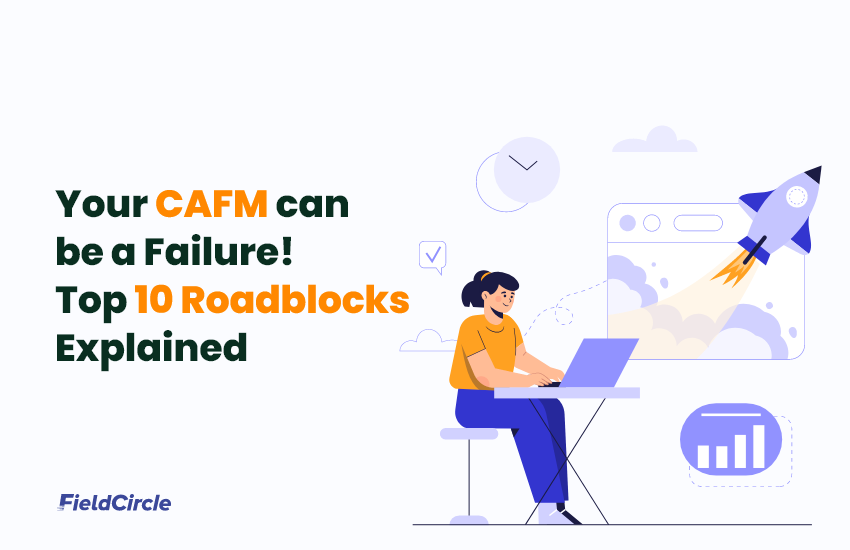Your CAFM can be a Failure! Top 10 Roadblocks Explained

Did you know that the Computer Aided Facility Market (CAFM) comprised 5 % of the global Facility market? According to a study by Future Market Insights in 2022 on this specific market, it is true!
You might also wonder why Facility Management is crucial for the success of your businesses. Well, it’s because this industry provides the essential tools and services needed to maintain and take care of buildings, infrastructure, and outdoor spaces. It’s all about ensuring everything works well, stays safe, and remains sustainable.
Safety is a critical reason behind the implementation of facility management, and a Computer Aided Facility Management System enhances the procedure. This digital tool streamlines and automates the management and maintenance of your workplace indoors and outdoors to create a secure and healthy environment, reducing the risk of accidents or harm to your employees. Plus, it helps foster a positive and efficient work atmosphere, ultimately boosting productivity and well-being among your staff. Unsurprisingly, the future of facility management industry will thrive well with the benefits of this computer-aided tool.
However, this application for facilities services may have some downsides. Complex operations and extensive systems require larger investments and longer months for installation, a significant drawback of this system. Eventually, this leads to losing money and power for a Facility Management team.
A Brief Overview of Computer-Aided Facilities Management
Computer-Aided Facilities Management is a technology developed to aid facility managers in efficiently handling assets, tools, and processes that significantly impact business continuity. Its primary objective is to simplify facilities management and maintenance tasks, leading to increased efficiency, improved business performance, and a smoother experience for facilities managers, employees, and other building users.
But what does this mean in practical terms? Before the advent of CAFM systems, facilities managers had to gather and manage vast information about their buildings through extensive paper records. This included spreadsheets, blueprints, layout documents, and folders, all of which needed constant updates with the latest details related to asset maintenance, space management, property information, and more.
Managing facilities in the traditional way was inefficient, labor-intensive, and often led to human errors. This tool was introduced to address these issues and provide support to facilities management professionals. This tool also enables data-driven decision-making for the facilities it oversees. A facilities management software primarily focuses on the physical workspace and its components. In the following section of this article, we will discuss in detail the reasons that may cause the unsuccessful implementation of an automated tool.
Top 10 Reasons for Unsuccessful Implementation of CAFM
The successful implementation of Computer-Aided Facilities Management solution can bring numerous benefits to an organization, including improved facility management and efficiency. Successful implementation of this digital application requires thorough planning, resource allocation, effective change management, stakeholder involvement, and proper training. However, the absence of these factors can lead to an unsuccessful implementation. Let’s discuss some key reasons:
1) Poor Planning:
Inadequate planning is a common reason for the implementation failure of this automated application. Achieving the desired outcomes is challenging without a clear roadmap and well-defined objectives. A lack of alignment with the organization’s strategic goals and needs can result in a mismatch between the digital tool’s ‘s capabilities and the actual requirements.
2) Insufficient Resources:
Successful implementation of a facility management app requires a significant allocation of resources, including time, money, and personnel. Underestimating these requirements can lead to a lack of necessary resources during implementation. An organization may also lack the IT infrastructure and support to run the application effectively.
3) Resistance to Change:
Resistance to change among employees and stakeholders can hinder the adoption of this solution. If the end users are not onboard, they may not use the system as intended, which can reduce its effectiveness. Failure to communicate the benefits and purpose of the system to the staff can exacerbate resistance.
4) Inadequate Training:
Inadequate training is a significant roadblock to successful implementation. The facilities team must be adequately trained to use the tool to its full potential. The absence of proper training can result in frustration, reduced productivity, and a general mistrust of the system.
5) Data Quality Issues:
This tool uses accurate and up-to-date data to function effectively. Poor data quality or incomplete data can lead to errors and inefficiencies. Data migration from legacy systems can be challenging and result in inconsistencies or loss.
6) Complex Software:
Some applications in this category can be overly complex or offer features that are not relevant to the organization’s needs. Implementing an extremely complicated operating system can lead to confusion and underutilization. The tool may require customization to align with specific workflows, which can be time-consuming and costly.
7) Lack of Stakeholder Involvement:
Successful implementation of this tool requires active involvement from all stakeholders, including facilities managers, IT, end-users, and executives. Failing to engage these groups can lead to misunderstandings and resistance. Insufficient communication and collaboration between different departments can also be problematic.
8) Inadequate Vendor Support:
Organizations may face issues if the solution vendor does not provide adequate support, updates, or training. Poor vendor support can lead to unresolved technical issues and hinder the software’s performance.
9) Scope Creep:
Expanding the scope of the product implementation beyond the original plan can lead to delays and budget overruns. Sticking to the defined project scope and gradually introducing additional features as needed is essential.
10) Inadequate Change Management:
Effective change management strategies are critical to address cultural shifts and ensure the successful adoption of the application. Failure to engage employees in the change process can result in pushback and a lack of enthusiasm for the new system.
How to successfully implement a CAFM?
A successful CAFM implementation requires careful planning, effective execution, and ongoing management. Here’s a guide to help you implement successfully:
· Define Your Objectives and Requirements:
Start by identifying your organization’s specific goals and objectives for implementing this automated tool. Understand what you want to achieve, whether improving space utilization, enhancing maintenance efficiency, or reducing operational costs.
· Engage Stakeholders:
Involve key stakeholders in the decision-making process, including facilities managers, IT teams, end-users, and executives. Gather input and ensure that your installed system aligns with the needs and expectations of all relevant parties.
· Select the Right CAFM Software:
Research and evaluate relevant product options in the market. Choose a solution that aligns with your objectives, is user-friendly, and provides the necessary features. Consider scalability to accommodate future growth.
· Plan the Implementation:
Develop a detailed implementation plan that includes project timelines, milestones, and responsibilities. Identify potential risks and mitigation strategies. Plan for data migration from existing systems if applicable.
· Data Preparation:
Ensure your data is clean, accurate, and complete. This may involve data cleansing and standardization. Prepare your existing data for migration to the new system.
· Customization and Configuration:
Work with your vendor to customize and configure the system to meet your requirements. This may include setting up user roles, workflows, and reporting tools.
· Training and Education:
Provide comprehensive training for users and administrators to use the tool effectively. Create user guides and training materials and offer continuous knowledge support during the implementation.
· Lower Environment Testing:
Conduct a pilot phase or a lower testing environment for the automated system with a smaller group or specific facilities to identify any issues or areas for improvement. Gather feedback from the team members during this testing phase to make necessary adjustments for a successful implementation.
· Full Implementation:
Implement the digital tool to the entire organization in stages, along with best practices of facility management, ensuring a smooth transition. Monitor the implementation closely, promptly address issues, and provide support as needed.
· Change Management:
Implement a change management plan to address cultural shifts and user adoption. Communicate the benefits of the new system and guide the transition.
· Data Migration:
If applicable, execute the data migration from your legacy systems to the latest version. Verify the accuracy of the migrated data.
· Monitoring and Evaluation:
Continuously monitor your installed system’s performance and user satisfaction. Collect feedback and make improvements as necessary. Evaluate key performance indicators (KPIs) related to your objectives, such as space utilization, maintenance efficiency, and cost savings.
· Ongoing Support and Maintenance:
Establish processes for ongoing system maintenance and support. Ensure that software updates, security patches, and data backups are regularly performed. Provide help desk support and resources for users as needed.
· Ensure Sustainable Improvement:
Regularly review and assess the implemented system’s performance and consider enhancements or additional features that could further benefit the organization.
Conclusion
When implementing a Computer-Aided Facilities Management system, it is essential to consider future needs. According to a study by Future Market Insights, the future market for CAFM is expected to grow exponentially. In 2022, the global Computer Aided Facility Management market was worth $987.5 million. Experts predict it will soar to $2801.4 million by 2032, with a steady annual growth rate of 5.7%.
To achieve maximum effectiveness without extensive human involvement, sophisticated technologies like Artificial Intelligence are used in this sector. For instance, the above-mentioned report by Future Market Insights says that implementing AI in facility management has enabled organizations to save 50% on preventive maintenance and reduce the risk of human error. FieldCircle helps you manage your facility operations more efficiently and streamlined for optimum productivity. Schedule a demo today to learn more!


